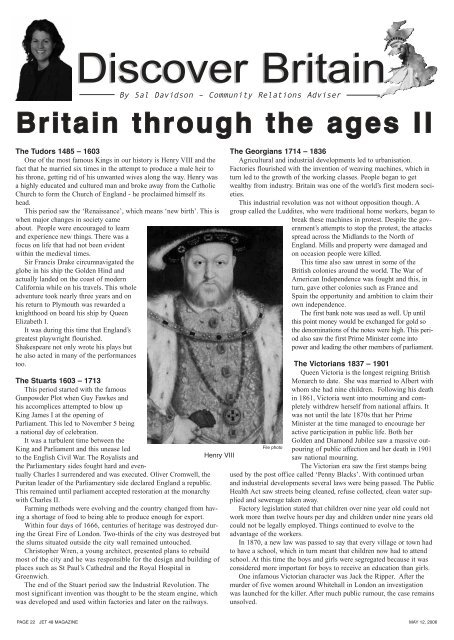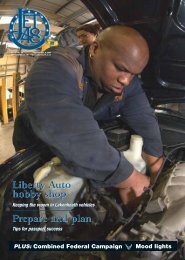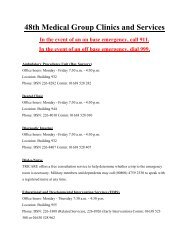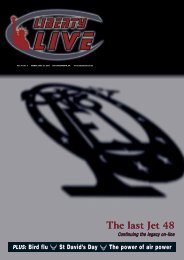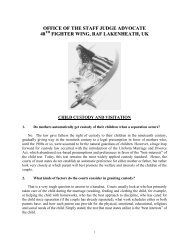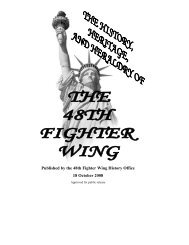12 - RAF Lakenheath - Air Force Link
12 - RAF Lakenheath - Air Force Link
12 - RAF Lakenheath - Air Force Link
You also want an ePaper? Increase the reach of your titles
YUMPU automatically turns print PDFs into web optimized ePapers that Google loves.
By Sal Davidson – Community Relations AdviserBritain through the ages IIThe Tudors 1485 – 1603One of the most famous Kings in our history is Henry VIII and thefact that he married six times in the attempt to produce a male heir tohis throne, getting rid of his unwanted wives along the way. Henry wasa highly educated and cultured man and broke away from the CatholicChurch to form the Church of England - he proclaimed himself itshead.This period saw the ‘Renaissance’, which means ‘new birth’. This iswhen major changes in society cameabout. People were encouraged to learnand experience new things. There was afocus on life that had not been evidentwithin the medieval times.Sir Francis Drake circumnavigated theglobe in his ship the Golden Hind andactually landed on the coast of modernCalifornia while on his travels. This wholeadventure took nearly three years and onhis return to Plymouth was rewarded aknighthood on board his ship by QueenElizabeth I.It was during this time that England’sgreatest playwright flourished.Shakespeare not only wrote his plays buthe also acted in many of the performancestoo.The Stuarts 1603 – 1713This period started with the famousGunpowder Plot when Guy Fawkes andhis accomplices attempted to blow upKing James I at the opening ofParliament. This led to November 5 beinga national day of celebration.It was a turbulent time between theKing and Parliament and this unease ledto the English Civil War. The Royalists andthe Parliamentary sides fought hard and eventuallyCharles I surrendered and was executed. Oliver Cromwell, thePuritan leader of the Parliamentary side declared England a republic.This remained until parliament accepted restoration at the monarchywith Charles II.Farming methods were evolving and the country changed from havinga shortage of food to being able to produce enough for export.Within four days of 1666, centuries of heritage was destroyed duringthe Great Fire of London. Two-thirds of the city was destroyed butthe slums situated outside the city wall remained untouched.Christopher Wren, a young architect, presented plans to rebuildmost of the city and he was responsible for the design and building ofplaces such as St Paul’s Cathedral and the Royal Hospital inGreenwich.The end of the Stuart period saw the Industrial Revolution. Themost significant invention was thought to be the steam engine, whichwas developed and used within factories and later on the railways.Henry VIIIThe Georgians 1714 – 1836Agricultural and industrial developments led to urbanisation.Factories flourished with the invention of weaving machines, which inturn led to the growth of the working classes. People began to getwealthy from industry. Britain was one of the world’s first modern societies.This industrial revolution was not without opposition though. Agroup called the Luddites, who were traditional home workers, began tobreak these machines in protest. Despite the government’sattempts to stop the protest, the attacksspread across the Midlands to the North ofEngland. Mills and property were damaged andon occasion people were killed.This time also saw unrest in some of theBritish colonies around the world. The War ofAmerican Independence was fought and this, inturn, gave other colonies such as France andSpain the opportunity and ambition to claim theirown independence.The first bank note was used as well. Up untilthis point money would be exchanged for gold sothe denominations of the notes were high. This periodalso saw the first Prime Minister come intopower and leading the other members of parliament.The Victorians 1837 – 1901Queen Victoria is the longest reigning BritishMonarch to date. She was married to Albert withwhom she had nine children. Following his deathin 1861, Victoria went into mourning and completelywithdrew herself from national affairs. Itwas not until the late 1870s that her PrimeMinister at the time managed to encourage heractive participation in public life. Both herGolden and Diamond Jubilee saw a massive outpouringof public affection and her death in 1901File photosaw national mourning.The Victorian era saw the first stamps beingused by the post office called ‘Penny Blacks’. With continued urbanand industrial developments several laws were being passed. The PublicHealth Act saw streets being cleaned, refuse collected, clean water suppliedand sewerage taken away.Factory legislation stated that children over nine year old could notwork more than twelve hours per day and children under nine years oldcould not be legally employed. Things continued to evolve to theadvantage of the workers.In 1870, a new law was passed to say that every village or town hadto have a school, which in turn meant that children now had to attendschool. At this time the boys and girls were segregated because it wasconsidered more important for boys to receive an education than girls.One infamous Victorian character was Jack the Ripper. After themurder of five women around Whitehall in London an investigationwas launched for the killer. After much public rumour, the case remainsunsolved.PAGE 22 JET 48 MAGAZINE MAY <strong>12</strong>, 2006


